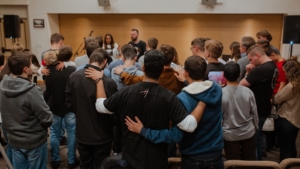“Each one of us has lived through some devastation, some loneliness, some weather superstorm or spiritual superstorm, when we look at each other we must say, I understand. I understand how you feel because I have been there myself. We must support each other and empathize with each other because each of us is more alike than we are unalike.” – Maya Angelou
 God created us for community. Deep down in our souls, we know this. Yet so often when we’re on a healing journey, we think it should be done alone. We choose to hide our struggles from others, try to “fix” them on our own, and isolate ourselves. Often, we think nobody else struggles as we do. Some may even feel shame and embarrassment when they decide to seek help.
God created us for community. Deep down in our souls, we know this. Yet so often when we’re on a healing journey, we think it should be done alone. We choose to hide our struggles from others, try to “fix” them on our own, and isolate ourselves. Often, we think nobody else struggles as we do. Some may even feel shame and embarrassment when they decide to seek help.
Throughout the Bible and Church history, we can see how God wired us to support one another. Jesus didn’t enter ministry alone. Moses didn’t follow God’s call alone. The church fathers were not solitary. We truly need one another. This is part of why counseling exists. Counselors are given the skills to come alongside people in their times of suffering, transition, stress, and pain.
Counselors can also lead group counseling. This experience can give a sense of community to people who may feel alone. This article will explore group counseling, looking at situations where group counseling may be beneficial and what to expect. Hopefully, this will be a useful resource if you’re considering this approach or if your counselor has suggested it.
What is group counseling?
The name tells you most of what you need to know. Group counseling is counseling that is done in a group. Usually, it occurs alongside 1:1 counseling but not always. In most cases, people are in a group with others that they don’t know. However, sometimes it is amongst coworkers, friends, peers, trauma survivors, or others that may already know each other.
Schools, churches, medical facilities, adoption agencies, and groups focused on specific health issues are examples of places that may host or encourage this approach. It can be done with a mixed age-range or people of the same age. Children, teens, and adults may all take part in groups. Some groups may be focused on a certain demographic while others are open to all.
 Support groups and addiction recovery groups are sometimes lumped into this approach as well. While these are great resources that should be used when needed, they are not group counseling. This is because they’re, typically, not led by a licensed counselor or therapist.
Support groups and addiction recovery groups are sometimes lumped into this approach as well. While these are great resources that should be used when needed, they are not group counseling. This is because they’re, typically, not led by a licensed counselor or therapist.
Nor are the members there with the intention of counseling. However, there may be counseling groups based on these same types of support areas. The intention and overall purpose of a group make a significant difference in defining what your purpose is.
When might group counseling be suggested?
In truth, most people could benefit from this experience at one point or another in their lives. It is a unique and helpful way to connect with others who are on a similar journey to you. Here are some situations where group counseling may be something to consider:
- Alcoholism
- Anger management
- Anxiety
- Birth trauma
- Couple’s support
- Depression
- Disabilities
- Divorce
- Drug addiction
- Eating disorders
- Grief
- Marriage support
- Parenting support
- Parents of children with learning disabilities
- Parents of children with special needs
- Parents of medically fragile children
- Parents of premature children
- Pornography addiction
- Postpartum depression
- Sex addiction
- Social skills
- Special needs
- Stress management
- Suicidal tendencies
- Traumatic experiences (Those who went through a shared traumatic experience often receive help from processing the experience with others who were also present)
What should I expect from this type of experience?
To a certain extent, it’s hard to say exactly what to expect because the needs of each group will vary. A group for postpartum mothers will have different needs than a group for people recovering from addiction. The following are general experiences. Keep in mind that each group will be unique and will be based on their own needs.

Groups will establish boundaries, rules, and individual expectations. Common expectations will be strict confidentiality is held. This will include not talking about your experience with others outside of the group, not sharing members’ names, not recording, and other privacy rules.
Some groups may have check-ins with one another in between meetings as an expectation. You may even be assigned a partner or buddy to do some homework or further discussion with in-between gatherings. These will all be done with confidentiality in mind.
Your group will also create goals together. Each member will likely be expected to set their own goals as well as goal setting for the larger group. These may be goals based on behavior, attendance, habits, progress, lessons, or other things. You may even make visual representations like charts or vision boards to capture these goals.
In most Christian groups, prayer will be part of the sessions. The meeting may begin and/or end with prayer. Sometimes members will be invited to pray. Other times the counselor will pray. In some situations, a priest, pastor, or chaplain will be present to offer spiritual guidance and support to the group as well.
The counselor(s) leading the group will be specially trained in whatever the group’s focus is. For example, a group for parents raising special needs kids will have a counselor who has done training on the best ways to support these parents.
They may even have a specific curriculum, book, program, or video series for you to work through. Sometimes the first part of the group session may be watching a video or reading something together. The second part of the session may be discussion time.
 When you first begin, you’ll likely do some team-building activities. These can include silly or serious ice break questions, games, art projects, activities, or even time playing with toys. They’re designed to help you all begin to feel comfortable with one another.
When you first begin, you’ll likely do some team-building activities. These can include silly or serious ice break questions, games, art projects, activities, or even time playing with toys. They’re designed to help you all begin to feel comfortable with one another.
Establishing a healthy and strong group is essential for substantial progress to be made. If there is someone in the group with whom you feel uncomfortable, make sure to talk individually with your group leader about it.
Guest speakers or presenters may join the meetings from time to time. Sometimes these are people who have graduated from the same program you are going through. They come to offer their advice, encouragement, and suggestions. It can be helpful to have time to visit with someone who is “on the other side” of what you’re going through.
An expert in the field may also come as a guest. In some groups, someone may come to offer a little bit of stress relief or pampering like a massage therapist or yoga instructor.
Meetings may occur in person or virtually. Often, they are held at the counseling office. They may be held at a workplace, church, community location, or any other private place. These also occur in in-patient settings in treatment facilities, rehabilitation facilities, addiction recovery programs, jails and prisons, and other settings.
The members will usually stay the same. Though in some cases, new members will be welcomed weekly or monthly. This is usually decided by the type of group. Individuals recovering from a shared traumatic experience will not be likely to add new members. Whereas a group focused on parents raising children with eating disorders will be more likely to add members as new parents need support.
Typically, gatherings are an hour to two hours long. Usually, a set time frame is established that a group will meet for. Some groups may meet for a year or longer. Most often groups meet once or twice a week. Twelve to twenty-four weeks is a common starting point.
Then groups may meet on a monthly, semi-annual, or annual basis from there. Groups may meet more often in the beginning and then taper off. 1:1 counseling is usually recommended alongside group counseling.
“People Walking”, Courtesy of Ryoji Iwata, Unsplash.com, CC0 License; “Worship”, courtesy of Adrianna Geo, Unsplash.com, CC0 License; “Posse”, Courtesy of Joel Muniz, Unsplash.com, CC0 License; “Autumn Leaves”, Courtesy of Providence Doucet, Unsplash.com, CC0 License










